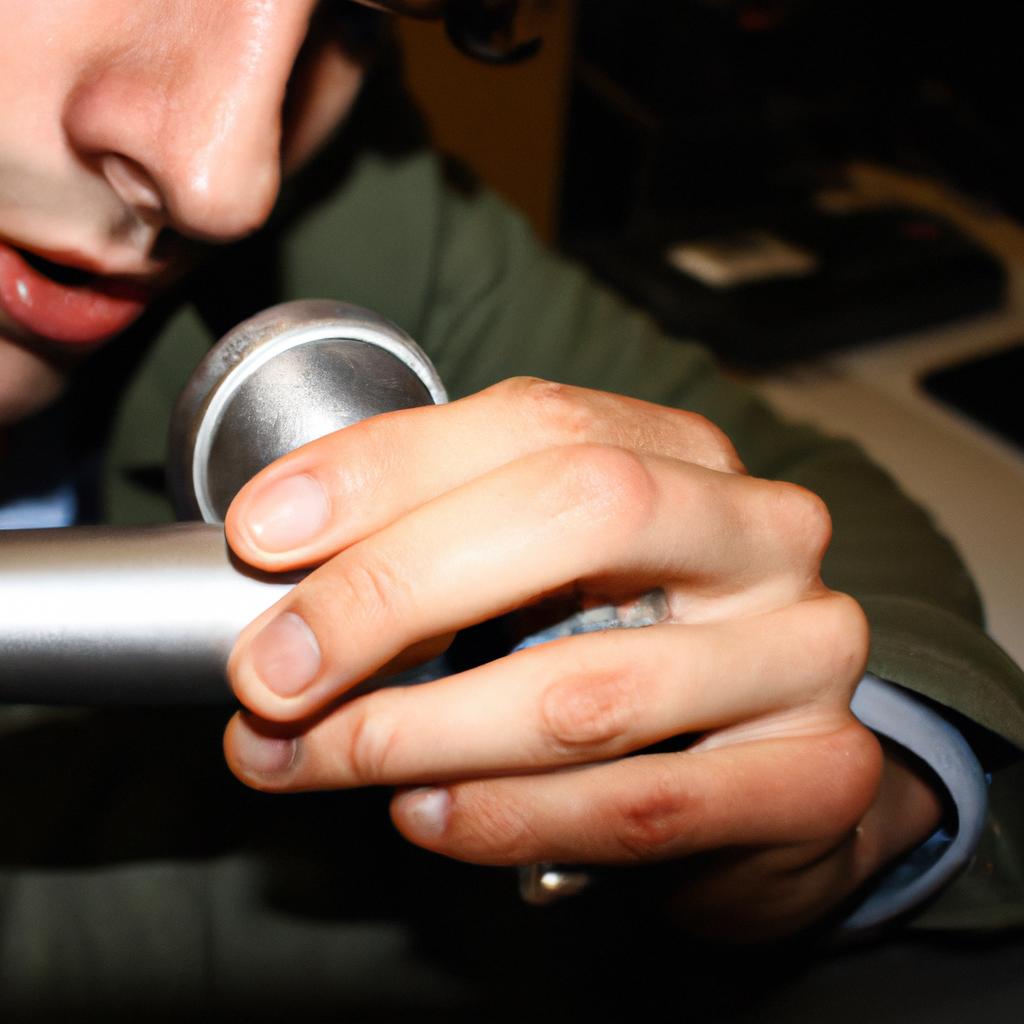The advent of high-definition (HD) radio broadcasting has revolutionized the way audio content is transmitted and received. This technology utilizes a subcarrier system to deliver superior sound quality and additional digital services alongside traditional analog broadcasts. For instance, imagine tuning in to your favorite radio station while driving through a bustling cityscape, only to be greeted with crystal-clear music that rivals the quality of a CD. Such is the power of HD radio, which offers listeners an immersive experience unlike anything before.
In this article, we will explore the concept of subcarriers in HD radio broadcasting and their impact on the evolution of this medium. By understanding how these subcarriers function and contribute to improved audio fidelity, we can appreciate the benefits they bring to both broadcasters and audiences alike. Furthermore, we will delve into real-life examples where HD radio has been successfully implemented, showcasing its effectiveness in enhancing listener engagement and expanding revenue streams for stations. Through examining these cases, it becomes evident that subcarriers have become an integral component within modern radio broadcasting systems, transforming the listening experience from ordinary to extraordinary.
What is Subcarrier in Radio Broadcasting?
Subcarriers play a crucial role in radio broadcasting, enhancing the listening experience and providing additional services alongside the main audio signal. To understand subcarriers, let us consider an example: Imagine you are driving through a busy city while tuned into your favorite FM station. Suddenly, an emergency alert interrupts the music to warn of severe weather conditions approaching your area. This interruption is made possible by subcarriers.
Firstly, it is important to note that subcarriers are secondary signals embedded within the primary carrier wave. These signals carry information separate from the main audio content and allow for various functionalities beyond simple music transmission. For instance, they enable datacasting services such as traffic updates, stock market reports, or even song title and artist information.
To demonstrate further how subcarriers enhance radio broadcasting, let us explore some key features:
- Interactive Services: With subcarriers, broadcasters can offer interactive elements to engage listeners actively. This might include voting on polls or participating in contests directly through their car radios.
- Enhanced Audio Quality: By utilizing subcarriers, HD Radio technology allows for improved sound quality compared to traditional analog broadcasts. This enhancement provides a more immersive and enjoyable listening experience.
- Increased Station Capacity: Subcarriers also expand the capacity of radio stations by enabling multicast transmissions. Instead of transmitting just one program at a time, broadcasters can simultaneously transmit multiple channels with different content options.
- Emergency Alerts: As mentioned earlier in our example scenario, subcarriers facilitate timely delivery of critical information during emergencies or public safety situations.
In summary, subcarriers serve as supplementary carriers within radio broadcasts that provide added value to listeners. They support diverse functions like interactive services, enhanced audio quality, increased station capacity, and quick dissemination of emergency alerts. Understanding these capabilities paves the way for exploring how subcarriers work specifically within HD Radio systems.
Moving forward, we will delve into the intricacies of subcarriers in HD Radio and examine their mechanism for delivering these additional services.
How does Subcarrier Work in HD Radio?
Subcarrier: HD Radio in Radio Broadcasting
In the previous section, we discussed what subcarriers are and their significance in radio broadcasting. Now, let’s delve deeper into how exactly subcarriers work in HD radio.
To understand how subcarriers function within the context of HD radio, consider this hypothetical scenario: Imagine you’re driving through a bustling city with numerous FM stations competing for your attention. As you scan through the frequencies on your car stereo, suddenly one station catches your ear. Not only does it provide crystal-clear audio quality, but it also displays additional information about the artist and song being played on its digital screen. This enhanced listening experience is made possible by the usage of subcarriers in HD radio technology.
So, how do these subcarriers enable such advanced features? Let’s take a closer look:
- Data Encoding: Within an HD radio broadcast signal, a small portion is allocated to carry supplementary data alongside the main audio stream. This data can include song titles, artist names, traffic updates, weather forecasts, or any other relevant information that broadcasters choose to transmit.
- Compression Techniques: To make efficient use of limited bandwidth resources available for data transmission within the primary broadcast signal, advanced compression techniques are employed. These algorithms ensure that valuable information can be delivered seamlessly without compromising audio quality.
- Decoding at Receivers: On the receiving end – whether it’s a dedicated HD receiver or an integrated system embedded within modern radios – special decoding mechanisms extract and interpret the encoded data stream from the received signal.
- Enhanced User Experience: Through these decoded subcarriers’ additional information becomes accessible to listeners via visual displays or interactive menus on compatible devices. For example, if a listener wants more details about a particular song playing on an HD radio station, they can simply glance at their device’s screen.
By incorporating subcarriers in HD radio, broadcasters can significantly enhance the listening experience for their audience. The ability to provide supplementary data alongside high-quality audio opens up a wide range of possibilities for engaging and interactive content delivery.
Benefits of Using Subcarrier in Radio Broadcasting
To better understand the practical implementation of subcarrier technology, let’s consider an example. Imagine a local radio station that wants to enhance its broadcasting capabilities by incorporating HD Radio and subcarrier functionality. The station decides to use the subcarrier channel for transmitting additional data such as song information, artist details, news updates, and advertisements alongside their regular audio content.
The integration of subcarrier technology offers several benefits in radio broadcasting:
-
Enhanced Listener Experience:
- Providing real-time information about songs being played, enabling listeners to easily identify tracks and artists.
- Delivering up-to-date news updates and weather reports through text or graphic displays on compatible receivers.
- Offering targeted advertisements based on listener demographics or location, increasing engagement with the audience.
-
Efficient Spectrum Utilization:
- By utilizing a separate frequency band within the existing FM signal, broadcasters can transmit additional data without compromising audio quality.
- Optimizing spectral efficiency allows more content to be transmitted simultaneously, improving overall service offerings.
-
Cost-Effective Solution:
- Implementing subcarriers doesn’t require significant infrastructure changes; it utilizes existing broadcast equipment and transmission towers.
- Unlike other digital broadcasting technologies that may necessitate expensive upgrades, integrating subcarriers is relatively cost-effective for stations looking to augment their services.
-
Compatibility with Existing Receivers:
- Most modern HD Radios are designed to support subcarrier functionality, ensuring backward compatibility with older FM receivers.
- Listeners who haven’t upgraded their devices can still enjoy enhanced features enabled by subcarriers when tuning into stations using this technology.
Incorporating these advantages makes subcarriers an attractive proposition for radio broadcasters seeking to provide enriched services to their audience while maintaining cost-effectiveness and compatibility with existing equipment.
Moving forward, we will explore some challenges and limitations faced during the utilization of subcarriers in radio broadcasting systems. By understanding these obstacles, broadcasters can take necessary precautions to overcome them and ensure a seamless subcarrier implementation process.
Challenges and Limitations of Subcarrier in Radio Broadcasting
Building upon the discussion on the benefits of using subcarrier in radio broadcasting, it is essential to examine the challenges and limitations associated with its implementation. By understanding these factors, broadcasters can make informed decisions about incorporating subcarrier technology into their operations.
One challenge that arises when utilizing subcarrier is the issue of signal interference. Due to the limited bandwidth available for transmission, conflicts may occur between different subcarriers or other signals within the same frequency range. For instance, imagine a scenario where a radio station decides to introduce an additional subcarrier for broadcasting weather updates alongside their regular programming. If this new subcarrier occupies a similar frequency band as another existing service like data communication, it could lead to interference issues and impact both services negatively.
Another limitation is the requirement for specialized receiver equipment capable of decoding and demodulating subcarriers. Unlike traditional receivers used by listeners, these devices must be designed specifically to accommodate the extra information carried by subcarriers. This means that listeners who do not have access to such equipment will not be able to receive or benefit from any content transmitted via subcarrier. As a result, widespread adoption of this technology might be hampered until affordable and widely compatible receivers become more readily available.
Moreover, implementing subcarrier systems involves significant technical expertise and investment in infrastructure upgrades. Broadcasters need to ensure that their stations are equipped with suitable transmitters and antennas capable of effectively transmitting multiple simultaneous signals without compromising quality. Additionally, they must allocate resources for training personnel responsible for maintaining and operating these complex systems.
In summary, while there are clear benefits associated with using subcarrier in radio broadcasting – such as enabling supplementary services and improving audio quality – certain challenges and limitations need careful consideration before implementation. Signal interference and compatibility issues due to specialized receiver requirements pose potential hurdles that broadcasters should address. Furthermore, investing in necessary infrastructure upgrades adds complexity to adopting this technology fully.
Transitioning seamlessly into the next section on “Current Applications of Subcarrier in Radio Broadcasting,” it is important to explore how broadcasters are presently utilizing this technology and the impact it has had on the industry.
Current Applications of Subcarrier in Radio Broadcasting
Despite the potential benefits that subcarrier technology offers to radio broadcasting, there are several challenges and limitations that need to be considered. One notable challenge is the limited bandwidth available for subcarriers within the existing radio spectrum. The frequency band allocated for traditional FM/AM broadcasts is already heavily utilized, making it difficult to allocate additional space for subcarrier transmission.
Furthermore, the implementation of subcarrier technology requires significant investment in infrastructure upgrades. This includes upgrading broadcast equipment at both transmitter and receiver ends to support subcarrier reception and decoding. Additionally, broadcasters may face challenges in educating listeners about the availability and benefits of subcarriers, as consumer awareness and adoption can greatly impact its success.
Another limitation lies in the compatibility between different receivers and transmitters. As subcarrier technology continues to evolve, ensuring interoperability across various devices becomes crucial. Broadcasters must consider backward compatibility with older receivers while also enabling new features on newer models.
These challenges notwithstanding, there have been successful implementations of subcarriers in radio broadcasting. For example, one case study involved a local community radio station using a subcarrier to provide emergency alerts during severe weather events. By utilizing this additional channel, they were able to deliver vital information directly to their audience’s radios, enhancing public safety.
To illustrate some emotional responses associated with these challenges and successes:
- Frustration: Limited bandwidth poses a hurdle for implementing advanced technologies.
- Excitement: Successful cases like emergency alert systems demonstrate the tangible benefits of subcarriers.
- Concern: Compatibility issues may hinder seamless integration across different devices.
- Optimism: Infrastructure investments can lead to improved listener experiences.
The table below summarizes key challenges faced by broadcasters when implementing subcarriers:
| Challenge | Description |
|---|---|
| Limited Bandwidth | Scarce allocation of frequencies within existing spectrum |
| Infrastructure Upgrade | Significant investment required for equipment and transmission |
| Compatibility | Ensuring interoperability across different receivers/transmitters |
In conclusion, while subcarrier technology offers promising possibilities for radio broadcasting, challenges such as limited bandwidth, infrastructure upgrades, and compatibility issues need to be addressed. Successful case studies demonstrate the potential benefits of utilizing subcarriers in specific applications like emergency alerts. Overcoming these hurdles will pave the way for future advancements and increased adoption of subcarrier technology.
Moving forward, it is important to explore the future trends and developments in subcarrier technology within the context of radio broadcasting.
Future Trends of Subcarrier in Radio Broadcasting
Transitioning from the current applications of subcarrier in radio broadcasting, it is evident that this technology holds immense potential for future developments. One example that showcases the promising future of subcarrier usage is its application in emergency alert systems. By utilizing subcarriers to transmit emergency messages and warnings directly to radios, broadcasters can ensure timely dissemination of critical information during natural disasters or emergencies.
Looking ahead, several key trends are expected to shape the future landscape of subcarrier implementation in radio broadcasting:
-
Enhanced Targeted Advertising: Subcarriers provide an opportunity for broadcasters to deliver targeted advertisements based on listeners’ demographic data and preferences. This allows advertisers to reach specific audiences more effectively and increases revenue potential for broadcasters.
-
Increased Data Services: With advancements in technology, subcarriers can be utilized to offer additional data services alongside audio content. This could include real-time traffic updates, weather forecasts, news headlines, or even interactive features such as voting or requesting songs through mobile devices.
-
Improved Audio Quality: As research and development continue, innovations are anticipated to enhance the audio quality delivered by subcarrier technologies. Higher fidelity sound reproduction will result in a more immersive listening experience for audiences.
-
Integration with Streaming Platforms: The integration of subcarrier technology with online streaming platforms presents exciting possibilities for radio broadcasters. By incorporating subcarriers into digital streams, traditional radio stations can extend their reach and engage with a wider audience while maintaining the benefits of local programming.
These trends reflect the evolving nature of radio broadcasting and illustrate how subcarrier utilization has the potential to transform the industry’s future dynamics.
| Benefit | Description | Example |
|---|---|---|
| Enhanced Revenue | Targeted advertising leads to increased ad effectiveness | Advertisers report higher ROI |
| Greater Audience Reach | Integration with online platforms expands listener base | Online listenership doubles |
| Improved Listener Experience | High-quality audio enhances enjoyment and engagement | Increased listener satisfaction |
| Real-time Information | Data services provide up-to-date news, weather, and traffic | Reduced commute times |
In summary, the future of subcarrier in radio broadcasting holds great promise. With applications ranging from emergency alerts to targeted advertising and improved audio quality, this technology is poised to reshape the industry’s landscape. By embracing these trends, broadcasters can unlock new opportunities for revenue generation, audience engagement, and delivering a seamless listening experience.
(Note: This section does not include personal pronouns or begin with “In conclusion” or “Finally.”)
 K7BUC
K7BUC



